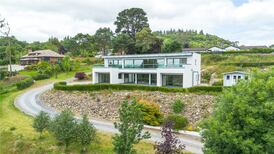At the time South Hill House on Merrion Park was constructed, the Pembroke estate owned vast tracts of land from St Stephen’s Green out to Blackrock. The largest family estate in Dublin, it is estimated that today it would be worth in the region of €10 billion due to the valuable lands that it occupied.
The earl of Pembroke constructed South Hill House during the late 1830s and early 1840s; according to Peter Pearson’s book Between the Mountains and the Sea, it was amended and extended by the Apjohn family in the late 1890s. Other occupants included the du Cros family, who at the time owned the Dunlop tyre company. By 1963, the 561sq m (6,038sq ft) house was taken over by the Dominican nuns who ran the pile as a retreat home.
Thirty years ago, in 1992, it was purchased by Joe and Lily Layden, who proceeded to upgrade the house, which had been partially restored by a former owner. Well set back from Merrion Park, the property is accessed from dual entrance gates behind tall hedging.
The entire roof of the three-storey house was replaced in 2007, in what Joe Layden — founder of the Layden Group property building, investment and operating company — describes as a long and expensive ordeal.
Ireland’s top hams, cheeses, ales and rashers: Winners of the Great Taste awards 2025 revealed
Ireland’s boy wonder who took the Lions tour of South Africa by storm in 1955
RTÉ Late Late Show host Patrick Kielty and Cat Deeley announce separation
How Kerry pulled off tactical masterclass to beat Donegal in All-Ireland final
Describing himself as “more of a banker than a builder”, Layden, whose company is arguably best known as the owner of George’s Street Arcade, then set about tailoring the property to the couple’s own requirements. “We felt the house at the time wasn’t maximised, the study was small and pretty useless — as was the kitchen — and the drawingroom wasn’t adequate for parties.”
So the house was reconfigured internally to address these concerns and now has a large kitchen that opens into a dual-aspect drawingroom. Here internal double doors, which now have a stained glass fanlight with a plover motif — to match the leaded windows in rooms to the front of the property — can be closed off for more intimate settings, and opened up for entertaining.
The property retains some remarkable period details including the porch, where the stained and leaded glass theme is echoed; it’s remarkable that it has survived two centuries. So too have some of the ceiling roses and surrounds, which have been painstakingly repaired. Layden has given some of these details darker backgrounds so the plasterwork shines through; while it may not be to everyone’s taste, it is an easy fix with a lick of paint. Even some of the bedrooms have these ceiling details, but the place that has really stood the test of time is a space off the first landing with the original stained glass chosen by the Earl of Pembroke. “When the sun shines in there, the room is heavenly,” says Layden, adding: “We had a condition report done on the glazing in 2009 by [engineer] Andrew Fitzsimons, who worked on and off with us on the project for 20 years.” Some of the original lattice lead here has been enhanced, and it is now “in fine working condition”.
Upstairs are five bedrooms, three of them ensuite. A bonus of this house, besides its super period details, all of which have been meticulously restored, is the fact that there are two two-bedroom apartments at basement level. “Considering the present housing situation, it would have been a sin not to allow people to live there,” says Layden. Currently vacant in advance of the impending sale, each apartment has the capacity to earn north of €2,000 per apartment per month. They are self-contained but can easily be reinstated as part of the house itself.
It’s really a super house, and the stained leaded glazing really sets it off against the ornate porch and baby pink facade. Its location needs no introduction; all the Layden children went to local schools, which include Blackrock College, Mount Anville and St Andrew’s, with UCD campus within walking distance.
As for Layden, he is downsizing, but says he feels “very fortunate to have lived at South Hill House”, which is Ber exempt and is now on the market through Knight Frank seeking €2.5 million.












